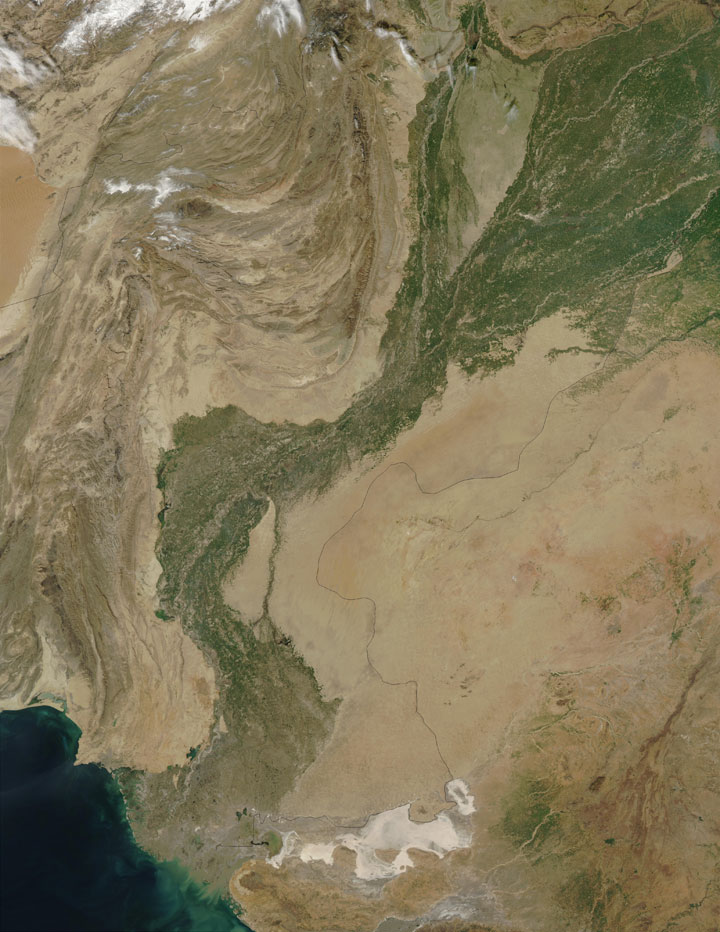
How much of the area that we now see as desert was actually forested in those times?
Gwen Robbins Schug
There are aspects of the ecological system in South Asia that have remained fairly constant since plate tectonic forces pushed the Himalayan Mountain range to a height that created a permanent monsoon system in the Arabian Sea. Other aspects of climate and environment are constantly changing. The Valley is also watered by seven rivers (and their tributaries) that emerge from the mountains North of Punjab and flow through what would otherwise be a desert region, known as Sindh. The climate today in the Indus Valley is semi-arid, watered by winter rains, seasonal streams, and human landscaping.
The natural ecological circumstances vary within the region but for the purposes of this discussion, it might be more important to notes that humans have interacted with and modified their environments to create new ecological systems for millennia and we know that process began in South Asia very early in the Holocene. We have evidence for fully domesticated animals and plants at Mehrgarh in the Bolan Valley by 7 kya BP and we know that the Indus Valley civilization was based on agriculture and pastoralism.
Many of the regions settled in the first urbanization, like Punjab, receive at least some rainfall in both the winter and summer monsoon season. Combined with seasonal streams and rivers, bunds, and irrigation, the region sustains a large amount of agricultural production today. Agricultural production is focused on wheat, barley, rice, millet, oil seeds, peas, beans, and some fruits and vegetables. Perhaps also true in the past, the calcareous desert, tropical arid brown, and alluvial sandy loam soils in the area can cause problems with salinity and alkalinity.
Based on the bioarchaeological evidence from faunal and floral remains, it seems that the Indus Valley was a breadbasket in the past as well. Animals like pigs, cats, dogs, wild ass, and even camels are evidenced in the archaeological record but there is no evidence they were eaten! Indus people raised cattle, buffalo, sheep, goats, and chickens for food; they grew a wide range of crops including wheat, barley, rice, millet, peas, beans, pulses, gram, seed oils, melon, dates, grapes, and jujube but cereals were the primary dietary staple (Weber 1999). Recently, some studies have suggested Indus people may have obtained the majority of their calories from wheat (Petrie et al. 2017). The relative importance of rice is still debated. Cities like Harappa were centers for trade, including exchange involving ingredients and other food items.
Thus this has been the predominant climatic and ecological situation for the latter half of the Holocene. However, there have been occasional climatic perturbations, rapid climate change events that were of sufficient magnitude to have impacted human populations in the past. Particularly relevant here is the 4.2ka BP event, evidenced by a large number of different kinds of paleoclimate proxy data and demonstrated across not only South but also Southwest Asia. This Rapid Climate Change Event was associated with increasing aridity, reductions in summer and winter monsoon rainfall and possibly also increased variability in the timing and amount of melt water in the Indus River Basin, a condition that persisted until 3.9ka BP.
It has been suggested that during this climatic change event, settlements in the Indus Valley that had formerly focused on either winter or summer cropping strategies increasingly began to incorporate crops from both strategies. At Harappa, where the winter rain strategy—focused on wheat and barley—had been predominant (making up 80% of the floated carbonized grains sampled in one study), lentils, peas, millet and fruit were also grown throughout the occupation at the site. However, as climate changed, people seemed to have relied on a more mixed strategy of both winter and summer crops and rice played an increasingly important role as a summer crop, which makes sense given the concept of adaptive diversity (Petrie et al. 2016).
Shereen Ratnagar
As far as reasoned inference goes the Indus alluvium was a fertile zone for raising crops and animals, and for fishing. The rainfall deficit in the area south or and including Harappa was compensated by the groundwater which was tapped by wells. We assume that the river channels functioned as routes for the transport of people and goods. The vegetation then would have been more varied and would have comprised tree growth that is scarce today.
Rita P. Wright
There was great variability within the indus civilization. Steven Weber in an issue of Man and Environment refers to agro-ecological variability. This variability therefore influenced the types of crops and methods of farming for example.
Paolo Biagi
Something, but not too much. Research has always been centered on just a few sites and the retrieval methods employed during excavation in most cases insufficient. Moreover, results from some very important sites remain unpublished!
Above: Indus River terrain, Courtesy Daily Geek Show
